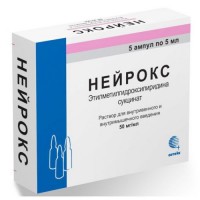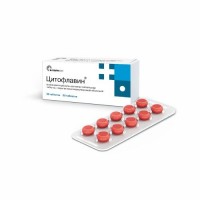Mediator 15 mg / ml 1 ml 10s solution for intramuscular and hypodermis.
- $40.30
Out Of Stock
The instruction for medical use of MEDIATORN medicine the Trade name of MEDIATORN the International unlicensed name Ipidakrin Lekarstvennaya a form Solution for intramuscular and hypodermic introduction, 15 mg/ml Structure of 1 ml of drug contains active agent - an ipidakrin of a hydrochloride monohydrate, in terms of an ipidakrin a hydrochloride of 15.0 mg, excipient - water for injections. Description Transparent colourless liquid Pharmacotherapeutic group Nervous system. Drugs for treatment of diseases of nervous system others. Parasympathomimetics. Antikholinesterazny drugs. The ATX N07AA code the Pharmacological Pharmacokinetics Later properties of parenteral administration of an ipidakrin a hydrochloride is quickly soaked up. The maximum concentration of active agent in blood plasma is reached in 25 – 30 minutes. Active agent quickly comes to fabrics, breaks a blood-brain barrier. After achievement of equilibrium distribution in blood plasma there are about 2% of active agent. It is generally metabolized in a liver by hydroxylation. Metabolites keep the same profile of action, but the expressiveness of their effects is much weaker. Elimination happens renalno and ekstrarenalno, removal with urine by canalicular secretion prevails, and only 1/3 doses are allocated by glomerular filtration. Final elimination half-life makes 2 – 3 hours. After parenteral administration of 20 - 35% of a dose it is removed with urine in an invariable look. It does not kumulirutsya. A pharmacodynamics Mediatorn – reversible inhibitor of cholinesterase. Drug directly stimulates carrying out an impulse in a neuromuscular synapse and in central nervous system owing to blockade of potassium channels of a membrane. Mediatorn strengthens action on unstriated muscles not only of acetylcholine, but also adrenaline, serotonin, a histamine and oxytocin. Mediatorn has the following pharmacological effects: · improves and stimulates neuromuscular transmission, · restores carrying out impulses in peripheral nervous system broken owing to influence of various factors (an injury, inflammation, influence of local anesthetics, some antibiotics, chloride potassium, etc.), · increases contractility of smooth muscle bodies under the influence of all agonists, except for chloride potassium, · moderately stimulates central nervous system in a combination with manifestation of separate sedations, · improves memory. Indications of the Disease of peripheral nervous system: mono - and polyneuropathy, a polyradiculopathy, a myasthenia and a myasthenic syndrome of various etiology. Diseases of the central nervous system (CNS): bulbar paralyzes and paresis, recovery period of the organic lesions of central nervous system which are followed by motive disturbances. Solution for injections to enter a route of administration and doses intramusculary or subcutaneously. The dose and duration of treatment should be defined individually depending on severity of a disease. Diseases of peripheral nervous system. Mono - and polyneuropathy of various genesis: subcutaneously or intramusculary to enter 5 – 15 mg of 1 - 2 time a day, a course of treatment of 10 - 15 days (in hard cases up to 30 days), further treatment it is necessary to continue by an oral form of an ipidakrin. Myasthenia and myasthenic syndrome: subcutaneously or intramusculary to enter 5 – 30 mg of 1 - 3 time a day, and then to pass to the tableted form. The general course of treatment makes 1 – 2 month. If necessary treatment can be repeated several times with a break between courses in 1 – 2 month. Diseases of the central nervous system. Bulbar paralyzes and paresis: subcutaneously and intramusculary to enter 5 – 15 mg of 1 - 2 time a day, a course of treatment – 10 – 15 days, to pass whenever possible to the tableted form. The recovery period in organic lesions of central nervous system: to intramusculary enter 10 – 15 mg of 1 - 2 time a day, a course of treatment up to 15 days. Children. There are no systematized data on use of a parenteral form of an ipidakrin to children (aged up to 18 years) therefore not to use drug to children. Side effects Often - hypersalivation, nausea - heartbeat, bradycardia - the strengthened sweating Infrequently - the strengthened discharge of a secretion of bronchial tubes - after use of high doses - dizziness, a headache, weakness, drowsiness, muscular spasms - allergic reactions (skin itching, rash) - vomiting Seldom - pains in epigastriums, a diarrhea Is unknown - a bronchospasm Salivation and bradycardia it is possible to reduce m-holinoblokatorami (atropine, etc.). In these cases reduce a dose or quickly (for 1-2 days) interrupt administration of drug. If you showed any side effects which are not specified in the instruction for use or any of the mentioned side effects is expressed especially strongly, we ask to see a doctor. Contraindications - hypersensitivity to an ipidakrin - epilepsy - extrapyramidal disturbances with hyperkinesias - stenocardia - the profound bradycardia - bronchial asthma - vestibular disorders - mechanical impassability of intestines and urinary tract - a peptic ulcer of a stomach or duodenum in an aggravation stage - children's and teenage age up to 18 years - pregnancy and the period of a lactation Medicinal interactions Mediatorn enhances sedation in a combination with means which suppress the central nervous system. Action and side effects amplify at combined use with other inhibitors of cholinesterase and m - cholinomimetic means. At patients with a myasthenia the risk of developing cholinergic crisis increases if Mediatorn apply along with cholinergic means. Risk of developing bradycardia increases if β-adrenoblockers were applied prior to the Mediatorn drug treatment. Mediatorn it is possible to apply in a combination with nootropic drugs. Alcohol enhances side effects of drug. Special instructions If the next dose is not entered, it is necessary to enter it whenever possible rather, but it is no more than appointed single dose. It is impossible to enter a double dose for substitution of the passed dose. With care to appoint in a thyrotoxicosis, diseases of a cardiovascular system and also to patients with respiratory diseases in the anamnesis or in acute respiratory diseases. Features of influence of medicine on ability to run the vehicle or potentially dangerous Mediatorn mechanisms can have sedative effect therefore persons at whom by-effects from the central nervous system are observed, for example, drowsiness should refrain from driving. Overdose Symptoms: a bronchospasm, dacryagogue, the strengthened sweating, narrowing of pupils, a nystagmus, strengthening of a vermicular movement of digestive tract, spontaneous defecation and urination, vomiting, jaundice, bradycardia, disturbance of intracardial conductivity, arrhythmia, a lowering of arterial pressure, concern, uneasiness, the excited state, sensation of fear, an ataxy, spasms, a coma, disturbance of the speech, drowsiness, the general weakness. Treatment: it is necessary to carry out symptomatic therapy, to apply m-holinoblokatory: atropine, Cyclodolum, Methacinum, etc. A form of release and packing On 1 ml in an ampoule, on 10 ampoules in blister strip packaging, on 1 blister strip packaging in a pack. To Store storage conditions in original packing at a temperature not above 25 °C. To store out of children's reach. Period of storage 2 years. Not to apply after expiry date. Prescription status According to the prescription PJSC Galichpharm Producer, 79024, Lviv, Opryshkovskaya St., 6/8, Ukraine the Name and the country of the owner of the registration certificate of PJSC Galichpharm, 79024, Lviv, Opryshkovskaya St., 6/8, Ukraine the Name, the address and a contact information of the organization in the territory of the Republic of Kazakhstan, the accepting claim (offer) on quality of medicines from consumers and responsible for post-registration observation of safety of medicine: Pharmamed Trading House LLP, Almaty, Hodzhanov Street, building 67, settlement 4a Ph.: +7 (727) 344-99-05/06








